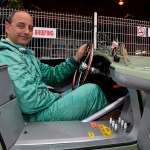 Andrew Frankel has been racing cars for over 20 years and testing them for nearer to 30. He is senior contributing writer to both Autocar and MotorSport magazines, sits on the Car of the Year jury and was chief car tester for the Sunday Times for 15 years. He cites driving and writing as the only disciplines for which he has any talent and therefore considers himself vocationally employed. When he is not working he lives quietly in the Wye Valley with his family, a small and unimportant accumulation of cheap old cars and some sheep.
Andrew Frankel has been racing cars for over 20 years and testing them for nearer to 30. He is senior contributing writer to both Autocar and MotorSport magazines, sits on the Car of the Year jury and was chief car tester for the Sunday Times for 15 years. He cites driving and writing as the only disciplines for which he has any talent and therefore considers himself vocationally employed. When he is not working he lives quietly in the Wye Valley with his family, a small and unimportant accumulation of cheap old cars and some sheep. ![]()
I hate to sound smug, but it is very rare I have a Goodwood drive lined up before Christmas – which I have – and unless Mrs Frankel has a Lola T70 secreted somewhere about the house, which I sadly very much doubt, this is the best present I’m going to get all season.
The event is the 74th Member’s Meeting, the race the SF Edge Trophy for pre 1923 Brooklands racers, the car a 1922 TT Bentley.
Bentleys had been racing and winning even before the first cars started finding their way to customers at the end of 1921, two years after the 3-litre had first been shown. But, bar a disastrous entry into the 1922 Indianapolis 500 upon which I’ll dwell no more other than to say the one works car qualified and finished dead last, the first race in which Bentley took part as an official team was the 1922 Tourist Trophy on the Isle of Man.
Three cars were entered, one for intrepid Indy pilot Douglas Hawkes, one for Frank Clement (the only professional racing driver ever employed by the company) and one for none other than WO Bentley himself who’d be taking part in his fourth TT after one in a DFP and two on motor-cycles. There was no chance of winning as Bentley was still in its infancy while the established and very successful Sunbeam team also had three cars but racing was in WO’s blood as was the ‘race on Sunday, sell on Monday’ mantra.

The event took place in filthy conditions, the Bentleys having makeshift wings attached on one side to keep the worst of the mud off the driver – with no thought whatever for the poor bespattered riding mechanic on the other side of the car. A Sunbeam driven by future Bentley Boy Jean Chassagne won, but the white Bentleys with their odd horseshoe radiators came home second, fourth and fifth. Interestingly ‘The Autocar’ reckoned WO was the fastest of his three drivers despite finishing fourth, and did not know the floorboards of his car broke up soon after the start and that he drove for five hours with nothing but fresh air between his pedals and his seat.
The result caused such a sensation the organisers invented a Team Prize on the spot, requisitioning a trophy formerly used at a local farmers’ show. For Bentley it was a triumph not just of his engineering brilliance but also his marketing knowledge. According his autobiography the three cars were then put up for sale and ‘they went in a flash, at very satisfactory figures.’
I should say now the car I will race at 74MM is not one of them. I believe two of the three are lost and the third resides in the Indianapolis Speedway Museum. But ‘my’ car is not only identical in every respect, but is actually an even earlier car – chassis number 22 no less – itself a Brooklands racer in period and believed to have one or two components – such as its Claudel-Hobson carburettor – from one of the original TT cars.

It’s a properly strange car to drive. Beaded edge tyres held on to the rim at 80psi feel as different to a normal vintage race tyre as a vintage race tyre is to a slick, while a brakeless front axle means what little deceleration there is is provided via a handbrake and footbrake which operate separate shoes within the rear drums. The gearlever is external and control four ratios with, of course, no sign of syncromesh while the pedals are unhelpfully arranged to place the throttle in the middle and the brake on the right. And if that’s not enough to keep your brain buzzing, it is helpful to remember the only way the fuel is going to get from the tank where it lives to the engine where it’s needed is if you pump in through by hand, on every single lap of the race.
The car is surprisingly quick too: the body is wafer thin, there’s no dynamo and once you’ve fired it up you can throw away the battery because the car’s only electrical requirement is for sparks which are generated mechanically by twin magnetos. It’s slippery too, sufficiently so I would guess to be getting up towards three figures before the end of the Lavant Straight which, without belts, a cage nor any other significant safety device is probably fast enough for me.

&width=75)

&width=75)

&width=75&fastscale=false)

&width=75)
&width=75)
&width=75)